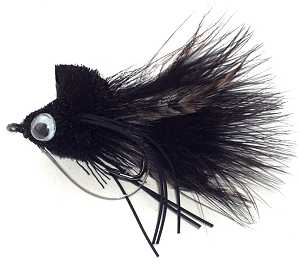The Black Diving Bass Bug
Larry Dahlberg’s Black Diving Bass Bug fly pattern was improved by Tim England when he changed the angle of cut in the deerhair to 90 degrees. Largemouth Bass are attracted to the more dramatic diving and darting motion this fly makes on the retrieve.

DEERHAIR BASS BUG FLY PATTERNS. Hook size 6 - $US each
When the sun goes down the bass seem to disappear for a while. They seem to take a break from feeding. They appear to have a rest before their next round of hunting and eating. Some say it is because the fish need time to adapt to the darker lighting conditions. Others because they now have to travel to different hunting grounds and it takes time to get there. What I have noticed is that I get a lot more takes, an hour or so after sunset. The time period varies depending if it has been a very sunny day or an over cast day. On sunny days the time period is longer. This could be due to the water temperature. Fishing at 2am the bass seem to be much more active than earlier on. The water has cooled down and the Bass appear to wake up
The feeding grounds the bass prefer during darkness are different to that during daylight. They are no longer interested in lurking under the cover of weeds, lily pads, old tree trunks and shoreline vegetation, where they can hide in safety and launch an ambush to secure their next meal. The bass now go hunting for natural cover that holds food. This can be the edges bordering around overhanging trees and shrubs, or it can be the edges near deep water. The latter are the best place to fish. Look for the outer edges of weed-beds, the drop off point where the shallow shore line edge changes into deep water, or any submerged steam bed that runs through the flats. The bass slowly cruise up and down these areas foraging for food. They keep on the move and do not stay in one spot unlike their daytime behavior. The problem with night fishing is that accurate casting is more difficult. If you fish in their other night time habitat you are in danger of getting tangled in the over hanging vegetation. The problems may be worth it though as the bigger fish seem to like lurking around these locations.
At night use big streamers to imitate baitfish. Visibility is very poor so the fish listen for their prey. Choose a streamer that displaces a lot of water when it is retrieved. Once the bass detect movement the come and investigate whether it looks edible. Fly color is not important, but traditionally black flies have been used. If you want to use surface bass bug flies use them near the over hanging vegetation near the shore line. Night bass bugging is slightly different to daytime. Let the bug land with a loud plop. On the forward cast stop the line suddenly. Use a slow but steady retrieve to try and imitate a land animal that has accidentally fallen in and is trying to swim to safety. Round faced deer hair flies and drivers are ideal. Do not use poppers as they are too noisy. Mice bass bugs are very successful at night



Bass Bug books

